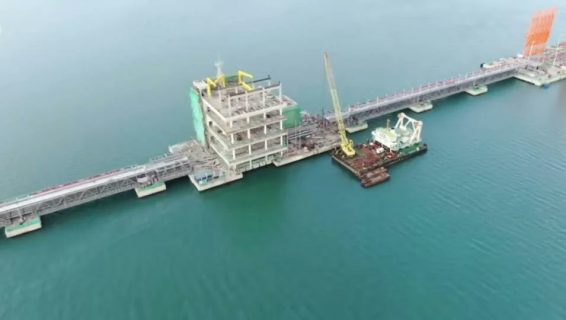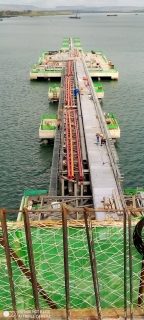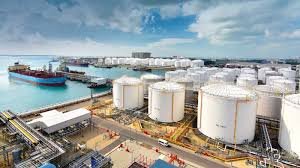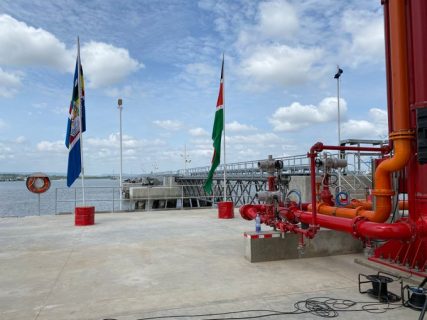The new Kipevu oil Terminal is an offshore island facility at Kenya’s Port of Mombasa and it’s currently the largest of its kind in Africa. The project commenced in 2019 and the construction was completed in January 2022.
The new Kipevu oil Terminal was built to replace an existing 50-year-old onshore terminal at the Port Reitz mainland. The old terminal can only handle one vessel at a time, whereas the new terminal is capable of handling up to four vessels.
The newly improved Kipevu oil Terminal now offers a total length of 770 meters and four berths. In addition, it also has one workboat wharf in the Westmont area for landing facilities. Kenya Ports Authority (KPA) provided funding for the project and China Communication Construction Company built the new terminal.
Project Overview
Kipevu Oil Terminal (KOT) project is a modern terminal developed by Kenya Ports Authority in Mombasa, Coast, Kenya.
The project’s contractors include China Road and Bridge Corporation (EPC) and CCCC Fourth Harbor Engineering Co Ltd. The scheme’s scope includes 12.3 million cubic meters of dredging work, the hydraulic wharf, the submarine, and onshore oil pipeline processing and installation.
The scheme was designed to greatly alleviate the demanding Kenya’s oil transportation and increase the port’s oil handling and storage capacity, which is of great significance in stimulating Kenya’s economic development.

Upon completion, the new upgraded modern oil terminal is designed to accommodate a capacity of four vessels of up to 200,000 Deadweight tonnage (DWT) replacing the current 50-year-old terminal that currently sits there. The scheme is being developed at a cost of $385m from KPA, built by the China Communications Construction Company.
It will have both land and subsea pipelines connecting it to the storage facilities in Kipevu with a capacity to steer five different fuel products. The products comprise heavy fuel oil, three white oil products (DPK-aviation fuel, AGO-Diesel, and PMS-Petrol), and crude oil.
Timeline
Oct 2014
Construction of a new oil terminal in Kenya to cost US$ 120m
Niras, an engineering firm based in Denmark has been awarded a contract by the Kenya Ports Authority for the design of a new oil terminal that will replace the existing Kipevu Oil Terminal (KOT). Once the design stage of the project is over, another firm will undertake the construction of the terminal at a cost of US$ 120m.
Niras is expected to design the new terminal at a cost of US$ 1.7m. Niras will also be in charge of supervising the construction works of the project. The new oil terminal will be four times larger than KOT, which will be shut down once the construction of the new one has been completed. This will be done in 2017 when the new terminal will be ready for use.
This project is being undertaken to meet the growing demand for petroleum products in the region. This will also allow offloading of tankers with a capacity of 200,000 metric tonnes, improving capacity and efficiency. The new oil terminal will be built at a new location and will be able to cater to four ships up from the current capacity of one ship being handled by KOT.
Kipevu Oil Terminal is currently the country’s primary facility receiving imported refined petroleum products. Its current capacity is not adequate to meet regional demand for petroleum products estimated at 450 million liters monthly. KOT does not only serve Kenya but also other neighboring land-locked countries of East and Central Africa.
Sep 2015
Plans for the construction of the Kipevu oil terminal in Kenya on course
The first designs for the construction of the Kipevu oil terminal in Mombasa are in the final stages so as to pave way for the tendering process; this is according to the Kenya Ports Authority Managing Director, Gichiri Ndua. The Kipevu oil terminal which is supposed to be relocated is being overseen by Danish consultancy firm Niras.
“We have engaged a consultant who is finalizing the construction designs in regard to the planned relocation of the Kipevu oil terminal,” Ndua said. KPA principal communication officer Hajj Masemo also said that the project is part of the Mombasa port infrastructure development.
“Everything is on course. Once we internalize the designs, we move to tender and construction which is expected to commence by end of this year,” said Masemo. Last year, according to the Kenya Economic Survey 2015, Kenya imported petroleum products worth Sh292.6 billion up from Sh252.7 billion the previous year.
The construction project which is expected to expand Kenya’s petroleum handling and storage capacity by almost 400 percent will be complete in 2018; it will allow four large tankers of up to 150,000 tonnes to berth at the same time.
This is such a key venture since Kenya is an important port of entry for bulk fuel importation among other imports into the hinterland, mainly in Uganda, Rwanda, and DR Congo.
Kenya presently has two oil terminals one at Kipevu located on the mainland Port Reitz which can accommodate a single vessel of up to 100,000 tonnes at a time and the other one at Shimanzi which can take in a 30,000-tonne vessel at a time.
Dec 2015
Kenya Ports Authority to construct new oil terminal
The Kenya Ports Authority (KPA) says the construction of a new oil terminal in Mombasa will start in 2016 in a bid to give way for the relocation of the old Kipevu terminal and help in the expansion of the country’s petroleum handling and storage capacity by about 400% including loading facilities.
The relocation of the oil terminal will be overseen by a Danish consultancy firm, NIRAS. Kenya Ports Authority Managing Director Gichiri Ndua said that the planned relocation had been finalized on and that the tendering process is projected to commence early next year.
The old Kipevu terminal which is 50 years now will be moved to a new location on the Southern side of the port and the relocation process will cost US$ 120m with the preliminary design costing US$ 1.7m.
“A new modern Oil Terminal to replace the current Kipevu Oil Terminal will be built at a newly identified site within the harbor. We have finalized the preliminary designs and the geotechnical investigations will be ready by New Year,” Ndua said.
A multidisciplinary consultancy company with over 1400 employees NIRAS is an international firm located in offices in Europe, Asia, and Africa. Their business is to provide impartial consultancy in a variety of fields such as construction and infrastructure, public utilities, environmental and natural resources, climate change and energy, planning, and development consulting.
April 2016
Kenya to start constructing a crude oil and refined fuel jetty
Kenya is yet to commence the construction of a new offshore crude oil and refined fuel jetty in October this year, the Kenya Ports Authority (KPA) has announced.
The new jetty is anticipated to increase efficiency in the delivery of refined fuel that is imported for Kenya’s domestic use and exported to Uganda, Rwanda, Burundi, and the eastern Democratic Republic of Congo.
KPA head of procurement Yobesh Oyaro confirmed the news and said that Denmark-based Niras will supervise on the construction of the new terminal that will replace the existing facility near the berth 19 container terminal.
“Denmark-based Niras will supervise on the construction of the new terminal that will replace the existing facility near berth 19 container terminal,” Oyaro said.
KPA which plans to build the jetty will construct it near Dongo Kundu from October to December 2019 and it will handle bigger tankers and hence relocate the existing Kipevu Oil Terminal from Port Reitz.
Oyaro further pointed out that relocation from Port Reitz to an offshore site will allow offloading of tankers with a capacity of 170,000 tonnes and this will improve the efficiency of the port and help in meeting the region’s growing demand for refined oil products.
The new island terminal will be advantageous since it will have four berths capable of facilitating the import and export of crude oil, heavy fuel oil, dual-purpose kerosene, diesel, and petrol, and is projected to make Mombasa Seaport a major trading hub.
The terminal will also comprise a crude oil pipeline that will connect it to the Changamwe-based Kenya Petroleum Refineries Ltd (KPRL). Kenya Ports Authority is a state corporation with the responsibility to maintain, operate, improve, and regulate all scheduled seaports on the Indian Ocean coastline of Kenya, including mainly Kilindini Harbour at Mombasa.
Sep 2018
Kenya to construct oil terminal at the port of Mombasa
Kenya in conjunction with the China Communications Construction Company (CCCC) is set to construct an oil terminal at the port of Mombasa; this is after the two parties signed an agreement.
Acting Managing Director for KPA Daniel Manduku confirmed the reports and explained that the current terminal at Kipevu can only handle one vessel at a time, with each vessel’s capacity being 35,000 tonnes. He also pointed out that currently, Kipevu handles 90 percent of oil imported to Kenya and petroleum products being transported to neighboring countries.
The capacity of the new terminal
According to the Kenya Ports Authority (KPA), the new terminal will see to an increase in discharge capacity over ten times, this means that the new facility will store up to 400,000 metric tonnes up from the current 35,000 tonnes.
The terminal will have the capacity to handle four vessels of up to 100,000 DWT (Dead Weight Tonnage) and will have a Liquefied Petroleum Gas (LPG) line that is expected to help stabilize the gas supply in the country.
Initially, construction was to be finalized by 2019 but the cancellation of an initial 2016 tender to include a liquified petroleum gas line pushed the completion time to 2022.
Mombasa port currently has only two oil terminals that are aging and too small to handle large quantities of imported oil and gas. The new US $400m Kipevu Oil Terminal will supplement the two facilities at Shimanzi and the old Kipevu terminal.
2019
The Sh40 billion Kipevu Oil Terminal (KOT) at the Port of Mombasa began in February following the award of the contract to China Communications Construction Company.
Kenya Ports Authority (KPA) acting managing director Daniel Manduku stated that the contract was awarded after the completion of due diligence by the tender committee weeks earlier. The modern terminal will have the capacity to handle four vessels and will have a Liquefied Petroleum Gas (LPG) line that is set to stabilize gas supply nationwide.
Dec 2019
Kipevu Oil Terminal construction in Kenya, 40% through
Construction of the US$385m new Kipevu Oil Terminal (KOT) is 40 percent completed after eleven months of work, according to Kenya Ports Authority. The project which is being developed by China Communications Construction Company(CCCC), began on February 1, aiming to be completed in 30 months. They expect it to be completed by August 1, 2021.
With the Kenya Ports Authority being the contractor of the new terminal, they will see the current 50-year-old Kipevu Oil Terminal relocated to a new site on the southern side of the port (near Dongo Kundu), opposite the current container terminal. Bernard Osero, head of corporate affairs at KPA reported that they are within the timelines in expanding capacity in oil handling reasonably ahead of demand.
2020.
Around forty percent of work had been completed on the Oil Terminal just 11 months after commencement. The scheme will entail USD 385 million investment.
China Communications Construction Company (CCCC) had planned the project construction to last for 30 months, completing 1 August 2021 but was pushed further after COVID-19 struck. The current 50-year-old Kipevu Oil Terminal will be shifted to a new area port’s southern part (near Dongo Kundu), opposite the side of the current container terminal.

2020 Oct.
The Kenya Ports Authority revealed that construction of the new Kipevu Oil Terminal in Kenya was 63.2% complete.
The managing director, engineer Rashid Salim added that works which began in February 2019 were slightly slowed down by the coronavirus: “We got some delays, however, we are now back on track and we are aiming to complete the construction works within the set period.
2020 Nov.
Dredging works were completed and Marine pilling started. Marine pilling is the task of creating deep foundations down in the ground below sea level giving support to structures and buildings that are offshore.
2021 April.
The new Sh40 billion Kipevu Oil Terminal at the Port of Mombasa was at the 84 percent completion stage. From September to April this year, the scheme, which is fully funded by the KPA, had gone up by 20.7 percent. The Kipevu Oil Terminal will be supplementing the two facilities at Shimanzi and the current Kipevu terminal.
2021 Oct.

The new Kipevu Oil Terminal is at 93.5 percent complete and will be capable of handling four vessels at once.
November 2021
By the end of November, the project was reportedly 96% complete and expected to be subjected to a dry run test in December 2021.
This was revealed by the Kenya Ports Authority, the company set to take over the terminal from China Communications Construction Company (CCCC), the executor, and run it before handing it over to Kenya Pipeline Company (KPC).
Dec 2021
KPA to Run Dry Tests on Kipevu Oil Terminal in December 2021
Kenya Ports Authority (KPA), the state corporation responsible for the maintenance, operation, improvement, and regulation of all scheduled seaports on the Indian Ocean coastline of Kenya has announced its plans to run dry tests on Kipevu Oil Terminal, which is currently 96% complete in December this year.
Just a reminder, the ports authority is the company that will take over the new terminal from the contractors immediately after construction, and runs it before handing it over to Kenya Pipeline Company (KPC), the state corporation responsible for the transportation, storing, and delivering petroleum products to the consumers of the East African Country by its pipeline system and oil depot network.
Overview of the Kipevu Oil Terminal
The construction of the Kipevu Oil Terminal began back in 2019. According to John Mwangemi, the acting KPA managing director the project has so far made significant progress and upon completion, by the end of this year, the site shall have four new berths capable of docking four vessels (three petroleum and one LPG) with a deadweight tonnage of 200,000 at a time.
The contractors have already laid down four sub-sea pipelines that will be used to connect the on-water terminal to storage facilities on the land, the KPC pipeline network that moves products to its storage facilities in the country, and Oil Marketing Companies’ terminals.
The new facility will have the capacity to handle crude oil, heavy fuel oil, and three types of white oil products i.e. DPK-aviation fuel, AGO-Diesel, and PMS-Petrol.
Plans to construct an LPG bulk storage facility at the site
Reportedly, KPC is currently in talks with Kenya’s Ministry of Energy and Petroleum to put up a dedicated Liquefied Petroleum Gas (LPG) bulk storage facility with an initial capacity of 25,000 tonnes.
The tender for the construction of the said facility should be ready in the next two to three months, according to the company’s general manager of infrastructure development, David Muriuki.
January 2022

President Uhuru Kenyatta on 6th January led Kenya in making another blue economy stride by inspecting and testing the Sh50 billion Kipevu oil terminal. The new four berths, whose total length is 770m will be receiving Jet fuel, Petroleum, Diesel, and LPG in one interval increasing the efficiency of the terminal which serves Kenya, Rwanda, and Uganda.
The oil terminal also has a workboat wharf for landing facilities in the Westmont area. The terminal will be handling 20 times more vessels than the previous Terminal.


MOMBASA MALINDI ROAD PROJECT WHEN TO START ? THIS YEAR JANUARY 2022 OR POSTPONED OR A THEIR ANY CHANGE ????
good project to our economy GOOD.
WE ALSO WAITING MOMBASA MALINDI ROAD PROJECT TO START THIS YEAR JANUARY 2022 ????
Details scanty on financier, terms, security, ownership of facility and management. Kenyans apprehensive on the #SriLanka experience with the Port of Mombasa. #ChineseDebt